| |

|
Monday, July 07, 2003
|
|
 How to Do Everything with your Pocket PC (Second Edition)
2:22:13 PM 
|
|
A Blog inspired by or in support of a book (Wired: A Romance by Gary Wolf). The book site links to it. The book site comes up when you browse to http://www.wiredaromance.com/, but browsing to the link above ends up under the same URL as well (some Name Server thing happening there). Amazon says this title gets rerleased tomorrow. Looks like a good read.
2:28:35 PM 
|
|

|
Friday, June 27, 2003
|
|
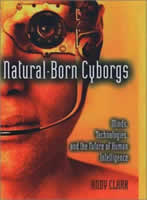
Just started reading. So far, pretty interesting. Good questions about the "status" of "external" pieces of scaffolding; the "extra" pieces of thought flow resources that help us to "handle" cognitive processes. The assumption under question is that of whether the only truly human "thoughts" are those that take place inside the skull, or in the "primitive bioinsulation", or the "good old fashioned skin-bag".
It fits right in with the ways we are thinking (and not thinking) about the "theological" and "spiritual" implications of this use and acceptance of pervasive computing in the Church context. MOvies like "The Terminator" and "The Matrix" set our culture on edge about the possible implications of human-machine interfacing. But Clark's discussions of "scaffolding" (a Heidegger-ian image) that augments and "takes notes" for us poses some interesting arguments for our utilization of "cyber-engines" for theological activity and for community.
9:32:23 AM 
|
|

|
Thursday, June 05, 2003
|
|

Back when I was working on that DMin project (focusing on Online Community and the Church), I ran across this article in WIRED mag. Jennifer Cobb soon published a book entitled Cybergrace, which sits on my bookshelf. She alerted me to a then a somewhat obscure theologian named Pierre Teilhard de Chardin. I had run across some insights of his via a seminary professor of mine, Glenn Hinson, who described the "Theistic evolution" concept to a youth group under my charge back in 1980 (we were having a weekend retreat, and the subject was Prayer, so we had Dr. Hinson, who was a writer of books on Prayer and Contemplation. I don't recall the tie-in to theistic evolution, but I suppose it was something alomg the lines of how one, to be "in nature" in order to be more closely atuned to the physical IN ORDER to be most aware of CREATION, and thus be in a state of "proximity" to God via that "mental mechanism" (actually, to "sit in creation" as a means to "be creature" and thus dependent upon and "in" God, just as God is IN nature.)
Anyway, Teilhard has been "adopted" by those enthralled with Online Spaces, as a "forseer" of the "networked spirituality" that now is discussed in some in the theological community (who also happen to be "geekily-inclined"). Cybergrace (published in 1998 by Crown Publishers, is a book I have lifted off my shelf and onto the desk where I will be picking it up again, to review 5 years later and see what this study says to me today, and what new angles on this field of study have emerged in these 5 years since. What with all the tools produced to run on the TCPIP networks, and my "hands-on" experiences since that time, I see the chances of "new thoughts" as high. Stay tuned.
12:02:26 PM 
|
|

|
Friday, May 30, 2003
|
|
Brasher relates a story that I want to relate to all those who dount the "draw" that the web can be for face-to-face communities. It is a story about a webiste of "Christ in the Desert Monastery", and is followed up by a story about a divorced man in his fifties, who happened upon the site, and ended up visting the monastery after becoming attracted to the "feel of the community" he received from the Website. (the story is related on pages 78-85)
10:17:04 AM 
|
|
Back in October 2002, I blogged some observations about Give Me that Online Religion by Brenda Brasher. (see Give Me That ONline Religion for that original post). Now, having picke it up again in recent days, as I ran across a few references to the book, I blogged a few days back about something........let me look it up
Anyway, "reloading it" may well have come after taking my son to see "The Matrix Reloaded", which kind of deflated me a bit at the end as it implied that everything in the story up till now was all a grand bit of AI. This may turn out to also be a trick, as the twists and turns will no doubt continue in the Sequel's sequel (part two, coming up in November)
9:35:17 AM 
|
|
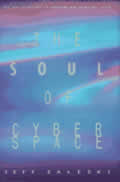
The Soul of Cyberspace by Jeff Zaleski is a "on the scene" book of interviews during vistis to several "Web incarnations" of attempts to strike up theological conversatrions with people on the Web.
If 55% of the world's Christians are Catholic, but less than 25% of the sites categorized by Yahoo in 1996 were Catholic, what does this tell us? Something more, I think (and is echoed by Zaleski) than the demographics of the Web (dominated by America) and of World Religion (most of America is Protestant, therefore affecting the percentages of Catholic-leaning Web fare). The issue of authority and of the value and role of "conversation" in theology is also a key factor. This one small example with wide implications from Zaleski is exemplary of the wealth of sociological and psychological explorations that can be mined from this book.
This book is definitely NOT to be confused with a similar title "The Soul IN Cyberspace" by Doug Groothius, which was a treatment which basically advanced a bibliolatry heresy, glorifiying the book, and making it a divine ordination; advancing the exclusivity of revelation from all channels OTHER than the written word (the "proof" adavanced was the Ten Commandments.
9:09:44 AM 
|
|

|
Thursday, May 29, 2003
|
|
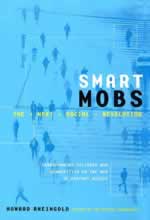 This book, which I picked up as soon as it was released last fall, had the same sort of impact on me as Rheingold's The Virtual Community did ten years ago. It described for me a fascinating social phenomenon of people connecting --- getting Wired up with each other, and the ways in which community blossomed in many online places and in many channels. Now, with the release of Smart Mobs, it is a new "unwired" , freed up channel, via Text messengers (often combined with portable phones) , PDAs, portable PC's , and "Blogging" live and on the go. I have a few posts back in the fall on Smart Church Mobs (I'll link it here shortly but you can search also on Smart Mobs and find it)
This book, which I picked up as soon as it was released last fall, had the same sort of impact on me as Rheingold's The Virtual Community did ten years ago. It described for me a fascinating social phenomenon of people connecting --- getting Wired up with each other, and the ways in which community blossomed in many online places and in many channels. Now, with the release of Smart Mobs, it is a new "unwired" , freed up channel, via Text messengers (often combined with portable phones) , PDAs, portable PC's , and "Blogging" live and on the go. I have a few posts back in the fall on Smart Church Mobs (I'll link it here shortly but you can search also on Smart Mobs and find it)
8:32:23 PM 
|
|
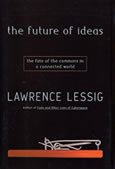 A Book that opned my ideas to the threat posed by the attempts to control various aspects of the Internet. Very interesting, and scary stories about the way monopolies are granted. Even more interesting are the ideas about the commons, and how everybody wins when the Internet, and software, are treated as commons instead of property, A Book that opned my ideas to the threat posed by the attempts to control various aspects of the Internet. Very interesting, and scary stories about the way monopolies are granted. Even more interesting are the ideas about the commons, and how everybody wins when the Internet, and software, are treated as commons instead of property,
6:39:06 PM 
|
|

|
Wednesday, May 28, 2003
|
|
 |
I bought the Cold Fusion MX Web Application Construction Kit just yesterday from Amazon, out of a sense of urgency to get going and learn this....already several contacts I have made are doing work in Cold Fusion. Since I'm already in the Macromedia fan corner, I might as well do it. |
|
The frustrating thing is, I had begun to see, back in December, that Cold Fusion was a handy thing to know. Three of my early contacts , all in December, all worked in Cold Fusion (I was aware of only one of those three were using it at the time). That was just before Christmas. After Christmas, thinking that I needed to spend as much time as possible selling my present skills, and that "surely something" was just around the corner, I never picked it up to start learning. A couple months later I had an interview, and the major strike against me was that I had no Cold Fusion experience. Soon after that, I bought the book, and began looking at it, but soon felt compelled to return it after what I thought had been a promising possibility of a temp project fell through. That was late March. Now, an additional two months later, Cold Fusion seems to be on half the available jobs I run across.
It all looks so familiar, from having been an ASP developer.....the learning curve seems to be quite manageable, and having an editor that will do code via a familiar WYSIWYG environment (Dreamweaver) makes it a candidate for even faster mastering. Forta's book seems quite complete (1500 pages). I hope to find some reputable training, if not just start working my way through this book and the accompanying CD. Forta also has another book that I ordered along with this one, which covers using Dreamweaver MX as the development environment for Cold Fusion MX. 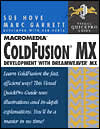 Coldfusion MX Development with Dreamweaver MX: Visual Quickpro Guide Coldfusion MX Development with Dreamweaver MX: Visual Quickpro Guide |
2:33:32 PM 
|
|

|
Saturday, May 24, 2003
|
|

|
Friday, May 23, 2003
|
|
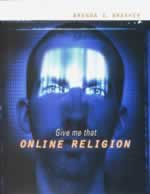
|
Give Me That Online Religion by Brenda Brasher. I read it last summer or so and soon after I was without a job. It had more to do with that, but the fact that I was reading this just before all that came down is also a bit telling of why I finally determined that "I had had enough --- even though I would not have consciously identified that at the time- at the time I was just so tied up in knots, so frustrated at how issues susch as these (in this book and elsewhere) were going to be a very long time , if ever, in coming to the radar there. |
| Click the picture to be taken to Amazon.com's page on the book |
11:54:21 AM 
|
|

|
© Copyright 2003 Dale Lature.
Last update: 9/23/2003; 2:35:16 PM.
|
|
| September 2003 |
| Sun |
Mon |
Tue |
Wed |
Thu |
Fri |
Sat |
| |
1 |
2 |
3 |
4 |
5 |
6 |
| 7 |
8 |
9 |
10 |
11 |
12 |
13 |
| 14 |
15 |
16 |
17 |
18 |
19 |
20 |
| 21 |
22 |
23 |
24 |
25 |
26 |
27 |
| 28 |
29 |
30 |
|
|
|
|
| Jul Oct |
|
|

